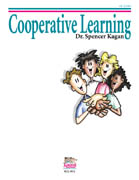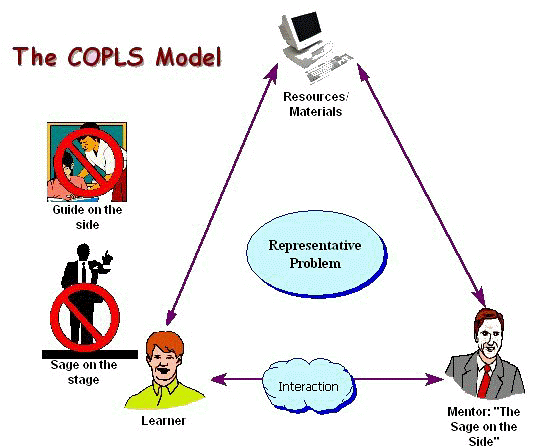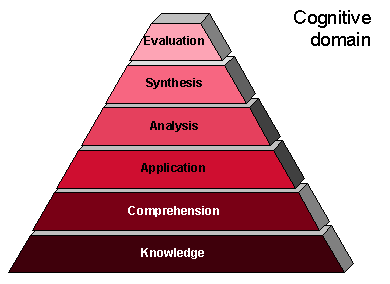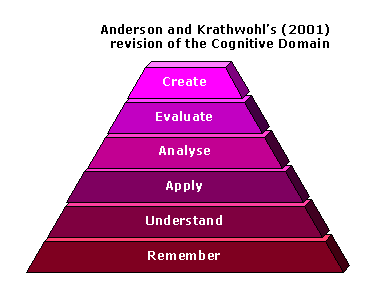The Graduate Manifesto of George Cassutto
Building a New Model of Teaching and Learning
Before entering the Virtual High School program, the model of instruction to
which I have been exposed in my own teacher training reflects many of the trends
popular with educators over the past two decades. The influence of education
pioneer Madeline Hunter is evident in the shape of instruction today, and her
ideas about constructivism mastery learning comprise a good part of the adaptive
philosophy that makes up the methodologies of the Virtual High School. Her
contribution to education can be seen in the movement towards standards-based
instruction. With the No Child Left Behind Act a reality, many states have
implemented standardized testing as a way to measure "adequate yearly
progress." Virginia has led the movement with its Standards of Learning
(SOL) tests. The courses, teachers effectiveness, and student performance that
would be the outcomes of the Virtual High School are subject to assessment by
way of these standards and standardized tests.
The basic structure of the lesson plan we were given in undergraduate teacher
training is primarily a product of Hunter's "direct instruction"
methodology. On my own website, I have
posted a lesson plan template that teachers can use as they develop their
own lessons. An explanation of each component can be found on this
page from the University of Montana at Billings.
 Another
influence on my own lesson and unit plan development is that of the cooperative
learning movement. When I cam on to the staff of North Hagerstown High in 1991,
my principal, Dr. Richard Gulas, instituted training for teachers in the area of
cooperative learning, which was based primarily on the work of Spencer
Kagan. Cooperative learning takes the emphasis in the traditional classroom
off of competition and shifts it to building at atmosphere of working together
so that the strengths of each student contribute to the achievement of all.
Kagan is also a driving force in the ideas of differentiated instruction and
multiple intelligences, a concept originated and expounded by Howard
Gardner. These trends call on the teacher to take time to develop lessons
and units that meet the emotional and educational needs of individual students.
These trends have been compounded with the federal requirements to create a
classroom where students with special needs can operate in the "least
restrictive environment." On a practical level, meeting the needs of
special education students within the regular classroom has led toward a trend
called "inclusion," where students with special needs are
"included" in regular education classes. A special educator co-teaches
the course so that the Individual Education Plan (IEP) of special education
students can be implemented.
Another
influence on my own lesson and unit plan development is that of the cooperative
learning movement. When I cam on to the staff of North Hagerstown High in 1991,
my principal, Dr. Richard Gulas, instituted training for teachers in the area of
cooperative learning, which was based primarily on the work of Spencer
Kagan. Cooperative learning takes the emphasis in the traditional classroom
off of competition and shifts it to building at atmosphere of working together
so that the strengths of each student contribute to the achievement of all.
Kagan is also a driving force in the ideas of differentiated instruction and
multiple intelligences, a concept originated and expounded by Howard
Gardner. These trends call on the teacher to take time to develop lessons
and units that meet the emotional and educational needs of individual students.
These trends have been compounded with the federal requirements to create a
classroom where students with special needs can operate in the "least
restrictive environment." On a practical level, meeting the needs of
special education students within the regular classroom has led toward a trend
called "inclusion," where students with special needs are
"included" in regular education classes. A special educator co-teaches
the course so that the Individual Education Plan (IEP) of special education
students can be implemented.
| How these trends will be integrated into the Virtual High
School model is as yet to be seen. But one positive aspect of the
mentor-student relationship is that it is characterized by flexibility.
The mentor can adjust and adapt the curriculum to meet the individual
learning styles, strengths, and weaknesses of the students with which
they are working. Mayeroff points out that "time and place fade in
significance, allowing students to complete work at their own speed,
within reasonable parameters" (pg. 86). Indeed, the integration of
technology into the Virtual High School curriculum can allow course
developers and mentors to provide greater motivation and chances for
success that what might be possible in the brick-and-mortar classroom. |
Indeed, the integration of
technology into the Virtual High School curriculum can allow course
developers and mentors to provide greater motivation and chances for
success that what might be possible in the brick-and-mortar classroom.
|

The COPLS (The Community of Practice Learning System).
The Virtual High School model provides the online student with a structure
for learning called the COPLS (The Community of Practice Learning System). The
key aspect of this non-traditional approach is that the student is challenged
with relevant, meaningful activities that lead the student to apply
"inert" information into useful situations. Each learning unit, or
module, is centered around a representative problem that acts as the central
theme for the module. Students still conduct research in order to fill in the
blanks in background knowledge, but they must put to use the bits of knowledge
they gather into a coherent whole. The final product is submitted to the mentor
for review and discussion. The mentor is the target audience, the knowledgeable
expert who acts as the "sage-on-the-side" through the entire learning
process.
The on-line structure involves the development of authentic
activities where the content being learned has a high correlation of relevance
to the life of the learner.
|
The design of an on-line module of learning mirrors the day-to-day activities
that a student would encounter in the traditional classroom. Traditional
activities might include reading and answering questions from the textbook,
viewing instructional videos, classroom discussions, simulations, and listening
to guest speakers. The on-line structure involves the development of authentic
activities where the content being learned has a high correlation of relevance
to the life of the learner. The web course designer must include activities that
build a student's basic knowledge on a given topic. |
Students gain the basic
building blocks of knowledge by conducting research or examining web resources
and even a traditional textbook. The difference is that these basics are
gathered with the intention of using them in the creation of a culminating
project, which is commonly known as "the challenge." The challenge is
structured in a such a way that the activities and practices of the real world
is reflected in its completion (Norton, 2003).
Once the student has gathered basic facts on the topic at hand, they must
then engage in the process of constructing new concepts that reveal a deeper
understanding of the topic. This process would reflect the "synthesis"
level of Bloom's taxonomy, where the student uses previously gained
understanding to create something new and original. The teacher can use these
new products as measures of learning in the form of student assessments.
Teacher-web designers must develop course content with assessment in mind,
leaving templates, rubrics, and keys online in the password-protected area of
the on-line course website called "mentor resources."
After the student has developed the challenge and its ancillary components
within the module, it becomes necessary for them to share with educators what
they have achieved. These adults, whether they be called teachers or mentors,
must have an opportunity to respond to the student's ideas, shaping their
understanding and correcting any pieces of misinformation or areas of knowledge
that are lacking in the final product. The mentor communicates with the student
via email, and on a more interactive level, through a chat session. The mentor
also has the opportunity to help the student make connections between the
element of learning in which they were engaged and the activities of
practitioners in the topic's field.
Technology is the building block that the web designer at at his or her
disposal to make learning on-line possible. The web designer is also an expert
in the academic subject field, which allows course content to be presented in
refreshing and compelling ways.
- At the lowest level, text and graphics are
presented with web pages for the student to consume.
- The traditional textbook is
also made available for the student, so the website may direct the student to
refer to pages within the textbook for additional information.
- The web designer
also has a responsibility to scour the Internet for the best on-line resources
and place them on the learning module.
- Reflection activities and basic knowledge
questions can come from these on-line resources as well.
- The student must be
able to respond to these materials either by completing a web-based form or by
inserting text into a blank Word document, all of which is sent electronically
to the mentor, who will review the incoming information and respond accordingly.
There are other tools at the disposal of both teacher-designers and
student-learners when communicating electronically.
- Teachers can post short MPG
video clips that can instruct students in technical or academic information.
-
Teachers can use PowerPoint to present information, or they can design PowerPoint
templates, which students use to insert basic information and return to the
mentor.Graphical information can be manipulated by the student within
PowerPoint, who then saves the file and sends it to the mentor.
- Activities can
be structured so that students plug in their own findings. The "Berma
shave" activities allow for this kind of structured sharing. In these short
response-based activities, students use what they have learned on-line or
in their textbook to to create short, rhyming poems. These are intended to
reflect some newly acquired concept.
- Students can develop brochures, usually in Microsoft Word, that cover a
broad topic of learning.
- Students can use Inspiration files to construct concept
webs and insert notes on those concepts. Any template provided for the student
helps structure their responses.
Many of these structures were seen by Virtual High School teachers as they
moved through the On-line Academy for Teachers (TOAT) modules. The TOAT modules
acted as models for teachers, who were functioning as on-line students. we were
able to see the variety of activities that on-line course developers have at
their disposal while emulating and simulating the challenges and accomplishments
of on-line learners.
 The
Missing Piece
The
Missing Piece
 Another
influence on my own lesson and unit plan development is that of the cooperative
learning movement. When I cam on to the staff of North Hagerstown High in 1991,
my principal, Dr. Richard Gulas, instituted training for teachers in the area of
cooperative learning, which was based primarily on the work of Spencer
Kagan. Cooperative learning takes the emphasis in the traditional classroom
off of competition and shifts it to building at atmosphere of working together
so that the strengths of each student contribute to the achievement of all.
Kagan is also a driving force in the ideas of differentiated instruction and
multiple intelligences, a concept originated and expounded by Howard
Gardner. These trends call on the teacher to take time to develop lessons
and units that meet the emotional and educational needs of individual students.
These trends have been compounded with the federal requirements to create a
classroom where students with special needs can operate in the "least
restrictive environment." On a practical level, meeting the needs of
special education students within the regular classroom has led toward a trend
called "inclusion," where students with special needs are
"included" in regular education classes. A special educator co-teaches
the course so that the Individual Education Plan (IEP) of special education
students can be implemented.
Another
influence on my own lesson and unit plan development is that of the cooperative
learning movement. When I cam on to the staff of North Hagerstown High in 1991,
my principal, Dr. Richard Gulas, instituted training for teachers in the area of
cooperative learning, which was based primarily on the work of Spencer
Kagan. Cooperative learning takes the emphasis in the traditional classroom
off of competition and shifts it to building at atmosphere of working together
so that the strengths of each student contribute to the achievement of all.
Kagan is also a driving force in the ideas of differentiated instruction and
multiple intelligences, a concept originated and expounded by Howard
Gardner. These trends call on the teacher to take time to develop lessons
and units that meet the emotional and educational needs of individual students.
These trends have been compounded with the federal requirements to create a
classroom where students with special needs can operate in the "least
restrictive environment." On a practical level, meeting the needs of
special education students within the regular classroom has led toward a trend
called "inclusion," where students with special needs are
"included" in regular education classes. A special educator co-teaches
the course so that the Individual Education Plan (IEP) of special education
students can be implemented.

